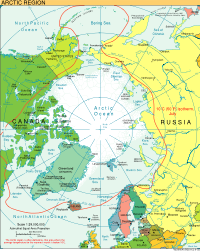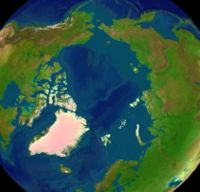Arctic
2007 Schools Wikipedia Selection. Related subjects: General Geography
The Arctic is the region around the Earth's North Pole, opposite the Antarctic region around the South Pole. In the northern hemisphere, the Arctic includes the Arctic Ocean (which overlies the North Pole) and parts of Canada, Greenland (a territory of Denmark), Russia, the United States ( Alaska), Iceland, Norway, Sweden and Finland. The word Arctic comes from the Greek word arktos, which means bear. This is due to the location of the constellation Ursa Major, the "Great Bear", above the Arctic region.
There are numerous definitions of the Arctic region. The boundary is generally considered to be north of the Arctic Circle (66° 33’N), which is the approximate limit of the midnight sun and the polar night. Other definitions are based on climate and ecology, such as the 10°C (50°F) July isotherm, which roughly corresponds to the tree line in most of the Arctic. Socially and politically, the Arctic region includes the northern territories of the eight Arctic states, including Lapland, although by natural science definitions much of this territory is considered subarctic.
The Arctic region consists of a vast ice-covered ocean (which is sometimes considered to be a northern arm of the Atlantic Ocean) surrounded by treeless, frozen ground. Life in the Arctic includes organisms living in the ice, fish and marine mammals, birds, land animals, and human societies.
The Arctic region is a unique area among Earth's ecosystems. The cultures in the region and the Arctic indigenous peoples have adapted to its cold and extreme conditions. In climate change research, the Arctic region is often considered an early warning system for the planet.
Nature
Climate
The Arctic's climate is characterized by cold winters and cool summers. Precipitation mostly comes in the form of snow. The Arctic's annual precipitation is low with most of the area receiving less than 50 cm (20 inches). High winds often stir up snow creating the illusion of continuous snowfall. Average winter temperatures can be as low as -37°C (-34.6°F) and the coldest recorded temperature is approximately -68°C (-90.4°F). Coastal arctic climates are moderated by oceanic influences, having generally warmer temperatures and heavier snowfalls than the colder and drier interior areas.
Plants
Since trees cannot grow in the climate, the vegetation of the Arctic tundra is composed of plants such as dwarf shrubs, graminoids, herbs, lichens and mosses, which are all comparatively close to the ground. As one moves northward, the amount of warmth available for plant growth decreases considerably. In the northernmost areas plants are at their metabolic limits, and small differences in the total amount of summer warmth make large differences in the amount of energy available for maintenance, growth and reproduction. Colder summer temperatures cause the size, abundance, productivity and variety of plants to decrease. In the warmest parts of the Arctic, shrubs are common and can reach 2 m (6 ft) in height; sedges, mosses and lichens can form thick layers. In the coldest parts of the Arctic much of the ground is bare, nonvascular plants such as lichens and mosses predominate, along with a few scattered grasses and forbs (like the arctic poppy).
Animals
- Polar bears have white fur so they can camouflage in the snow. This helps them to sneak up on seals when they’re hungry.
- The wolverine is part of the weasel family, and lives in holes in the ground. Though it is a small animal, it is very powerful.
- Arctic foxes are hard to spot in the snow because of their thick white fur. In the summer, their fur turns a brownish-grey colour.
- The Ptarmigan is a type of bird which nests in the snowy mountains, where they raise their young.
- Beluga means “white one” in Russian. Adults are white and the young are grey. This is so that the young can’t be seen easily by their predators. (Type of whale)
- Some other animals include the Arctic Wolf, Ringed Seal, Lemmings, and the Arctic Hare.
Paleo-History
During the Cretaceous, the Arctic still had seasonal snows, though only a light dusting and not enough to permanently hinder plant growth. Animals such as Chasmosaurus, Hypacrosaurus, Troodon, and Edmontosaurus may have all migrated north to take advantage of the summer growing season, and migrated south to warmer climes when the winter came. A similar situation may also have been found amongst dinosaurs that lived in Antarctic regions, such as Muttaburrasaurus of Australia.
International cooperation and politics
The Arctic region is a focus of international political interest. International Arctic cooperation got underway on a broad scale well over ten years ago. The International Arctic Science Committee (IASC), hundreds of scientists and specialists of the Arctic Council, the Barents Council and its regional cooperation have compiled high quality information on the Arctic.
Territorial claims
On December 20, 2001 Russia made an official submission into the UN Commission on the Limits of the Continental Shelf in accordance with the United Nations Convention on the Law of the Sea (article 76, paragraph 8). In the document it is proposed to establish new outer limits of the continental shelf of Russia beyond the previous 200 mile zone, but within the Russian Arctic sector. The territory claimed by Russia in the submission is a large portion of the Arctic, including the North Pole. One of the arguments was a statement, that the underwater Lomonosov Ridge and Mendeleev Ridge are extensions of the Eurasian continent. In 2002 the UN Commission neither rejected, nor accepted the Russian proposal, recommending to carry out additional research.
Canada (citing the Law of the Sea) claims control over the waterways throughout its 200-mile zone, which includes the Northwest Passage. This claim is not recognized by the United States.
A strategic military region
Some countries claim the Arctic has never been under the political control of any nation, although some nations' militaries have attached a strategic importance to the region. Canada has an outpost in the region ( Alert), and has long laid claim to much of the Arctic. Several recent excursions by the Canadian navy have taken place, with more planned to underline Canadian sovereignty in the region. In the 1950s and 1960s, the Arctic was often used by submarines to test new weapons, sonar equipment, and depth testing.
During the Cold War, the Arctic region was extensively monitored by the United States military and NATO, since it was believed that the first warnings of a nuclear strike from the Soviet Union would have been indicated by ICBMs launched over the North Pole towards the United States. The United States placed such importance on the region that two military decorations, the Arctic Service Ribbon and Coast Guard Arctic Service Medal, were established for military duty performed within the Arctic Circle.
In 2006, Envisat and EOS Aqua revealed a polar route connecting Spitzbergen and Siberia. Increased Russian activity has also been detected, though this can be attributed to the Chelyuskin icebreaker wreck expeditionary force.
Scientific exploration
Since 1937 the whole Arctic region was extensively explored by the Soviet and Russian manned drifting ice stations. Scientific settlements that were established on the drift ice were carried thousands of kilometers by the ice flow.
Pollution
The Arctic is comparatively clean, although there are certain ecologically difficult localized pollution problems that present a serious threat to people’s health living around these pollution sources. Due to the prevailing worldwide sea and air currents, the Arctic area is the fallout region for long-range transport pollutants, and in some places the concentrations exceed the levels of densely populated urban areas. An example of this is the phenomenon of Arctic haze, which is commonly blamed on long-range pollutants.
Effects of global warming
Arctic Waters
- Arctic Ocean
- Baffin Bay
- Beaufort Sea
- Barents Sea
- Bering Sea
- Bering Strait
- Chukchi Sea
- Davis Strait
- Denmark Strait
- East Siberian Sea
- Greenland Sea
- Hudson Bay
- Kara Sea
- Laptev Sea
- Nares Strait
- Norwegian Sea
Arctic Lands
- Alaska ( USA)
- Aleutian Islands ( USA)
- Bjørnøya (Norway)
- Canadian Arctic Archipelago
- Diomede Islands (Russia/ USA)
- Franz Josef Land (Russia)
- Newfoundland and Labrador (Canada)
- New Siberian Islands (Russia)
- Northwest Territories (Canada)
- Novaya Zemlya (Russia)
- Nunavik (northern Québec, Canada)
- Nunavut (Canada)
- Finnmark (Norway)
- Greenland (Denmark)
- Iceland
- Jan Mayen (Norway)
- Severnaya Zemlya (Russia)
- Siberia (Russia)
- Svalbard (Norway)
- Yukon (Canada)
- Wrangel Island (Russia)
The Arctic in Popular Culture
- Raising the Past by Jeremy Robinson
- Ice Hunt by James Rollins
- Deception Point by Dan Brown


